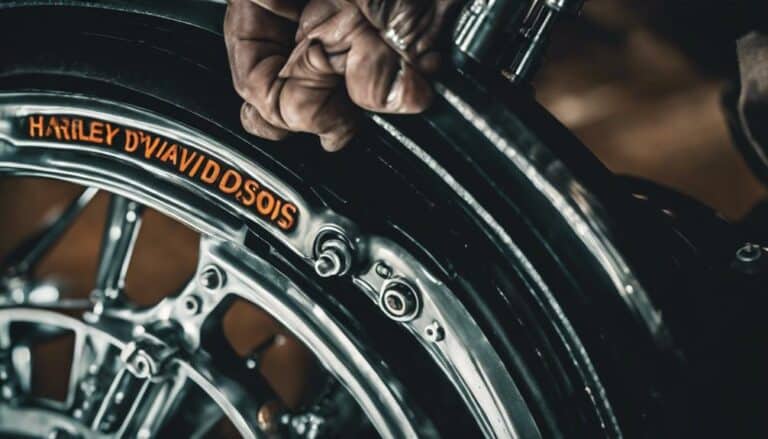You know the saying, 'A stitch in time saves nine'? When it comes to your Harley Davidson's wheel bearings, a little inspection now can save you from a whole lot of trouble later.
Imagine cruising down the road, the wind in your face, only to have a wheel malfunction. Stay tuned to discover the simple steps to ensure your wheel bearings are in top condition, keeping you safe on your Harley adventures.
Key Takeaways
- Utilize dial indicator to check for radial play and bearing wear
- Look for signs of damage like pitting, scoring, or leaks
- Ensure smooth rotation and absence of noise in bearings
- Reassemble components correctly, lubricate bearings, and test ride for abnormalities
Tools Needed for Inspection
To accurately inspect the wheel bearings on your Harley Davidson, certain essential tools are required for the task. Start by utilizing a dial indicator with a magnetic base to measure the end play of the wheel bearings accurately. This tool ensures precision in determining if adjustments are necessary for your bike's smooth operation. Additionally, a torque wrench is vital to guarantee the correct tightening of critical fasteners involved in the inspection process, securing the components effectively.
When examining the wheel bearings, a bearing puller tool becomes indispensable for removing them for a thorough inspection and potential replacement. Inspecting hard-to-reach areas around the wheel bearings is made easier with the use of an inspection mirror, aiding in the identification of any damages or signs of wear.
Lastly, have feeler gauges readily available to measure the end play and ensure it falls within the recommended 2-6 range, optimizing the performance of your Harley Davidson. These tools collectively empower you to maintain your bike's functionality and safety standards.
Lift and Secure the Bike
Elevate your Harley Davidson using a motorcycle lift to facilitate easy access to the wheels for the inspection process. Ensuring lift safety is crucial before hoisting the bike. Check the lift's weight capacity to guarantee it can handle your motorcycle.
Before lifting, inspect the lift for any signs of wear or damage that could jeopardize stability. Once the bike is elevated, secure it properly to prevent accidents. Use straps or clamps to hold the motorcycle in place securely. Verify the bike stability and make any necessary adjustments to achieve a level position.
Double-check all connections and confirm that the bike is firmly positioned on the lift. These maintenance tips are essential for a safe and effective wheel bearing inspection. Take the time to guarantee the bike is secure before proceeding.
Prioritizing bike stability and following inspection precautions will create a safe working environment for checking the wheel bearings.
Remove the Wheel
Loosen the axle nut and axle pinch bolts to detach the wheel from the motorcycle carefully. Slide the wheel out from the fork or swingarm, ensuring no damage occurs to the brake rotor or caliper. Place the wheel on a clean surface for a thorough inspection of the wheel bearings. Make sure the wheel is securely supported to prevent accidents during the inspection process. Check for wear, roughness, or play in the wheel bearings to determine if replacement is necessary.
| Wheel Removal Steps | Tips for Success |
|---|---|
| Loosen axle nut and pinch bolts | Use appropriate tools |
| Slide wheel out carefully | Avoid contact with brake components |
| Place wheel on clean surface | Prevent contamination |
| Inspect wheel bearings | Look for signs of wear, roughness, or play |
Taking these steps ensures a safe and effective wheel removal process, setting the stage for thorough bearing maintenance in the upcoming inspection.
Inspect the Bearings
After carefully removing the wheel from your Harley Davidson for inspection, the next step is to thoroughly examine the wheel bearings for any signs of wear or damage. Start by using a dial indicator to check for excessive radial play, indicating potential issues.
Look closely at the bearings for pitting, scoring, or discoloration, as these are clear indicators of wear. Ensure the bearings rotate smoothly without any roughness or grinding noises when spun by hand. Any excessive side-to-side movement in the wheel may suggest worn or damaged bearings.
Additionally, check for leaks around the bearing seals, as this could signal the need for replacement. Regular lubrication maintenance is crucial to keep the bearings operating smoothly and prevent premature wear. If any signs of wear or damage are present, bearing replacement is necessary to maintain the performance and safety of your Harley Davidson.
Reassemble and Test Ride
To ensure proper alignment and functionality, reassemble the wheel components following the manufacturer's specifications and torque settings. Make sure to apply proper lubrication to the wheel bearings as per the maintenance schedule. This step is crucial in maintaining the longevity and performance of your Harley Davidson.
Once reassembly is complete, it's time to conduct a test ride. Start by varying your speeds to evaluate the performance of the wheel bearings. Listen attentively for any unusual sounds like grinding, clicking, or humming, as these may signal underlying issues.
During the test ride, pay close attention to the handling and stability of the motorcycle. Any wobbling or vibrations could indicate problems with the wheel bearings. If you notice any abnormalities, it's essential to address them promptly.
If concerns persist, consider disassembling and inspecting the wheel bearings again to ensure a safe and smooth riding experience.
Conclusion
In conclusion, regularly checking and maintaining the wheel bearings on your Harley Davidson is crucial for optimal performance and safety.
By using the proper tools and techniques outlined in this article, you can ensure that your bearings are in good condition and prevent potential mechanical failures.
Remember to stay vigilant and proactive in your maintenance routine to enjoy a smooth and safe ride on your Harley Davidson.

